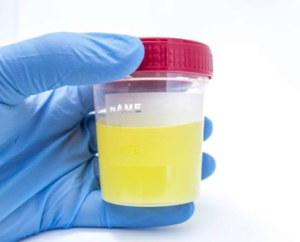
Urinalysis simply means analysis of urine. This is done with a person’s urine in order to identify signs of disease, infection or other issues. The test for urine is carried out using early morning urine.
The test involves the examination of different aspects of the urine including appearance such as cloudy or clear colour such as dark, light yellow, pale yellow or colorless.
The urine colour can change as a result of diet, medication, how much water your drink, and disease condition.
What are the 3 parts of a urinalysis?
When carrying out urine test, the following things are put into consideration;
- Physical appearance
- Chemical appearance and
- Microscopic solid known as culture test of the urine.
Physical Appearance: This is done by ones observation with the naked eye without any magnification. That which one sees or observes in his or her urine.
Chemical Appearance: This is a test done by checking the chemicals present in the urine. It is used to check whether there is ketone bodies present in the urine or not.
Microscopic Solid: This is carried out in the lab where they make use of microscope to check the urine in order to know the level of microscopic solids present in the urine and this is done by inoculating the bacteria and knowing the particular anti-bodies that will cure the disease or infections if seen.
What are the Physical Characteristics Of Urine?
The physical characteristics of urine are based on the following:
Volume
The average output of urine is about 1.5–2 liter per day, the volume increases by the intake of excess water and it may decrease by excessive sweating, degradation and kidney damage.
Smell
The normal urine has a faintly aromatic smell due to the presence of volatile organic acids. A person suffering from diabetic ketoacidosis may have a fruity smell due to the presence of acetone bodies in the urine.
Colour
Normal urine colour is amber or pale yellow in color, any other color apart these signifies other things which will be listed below.
Colors Of Urine And Its Significance
Transparent Or Clear: Is a sign of over hydration, the person has been drinking a little too much of water.
Pale Yellow: Means a person is healthy and hydrated
Transparent Yellow: Normal
Dark Yellow: Normal but needs to drink more water.
Brownish Orange: A sign of dehydration or possible of liver color.
Pinkish Red: Possibly a sign of kidney tumor
Blue Or Green: A sign of a rare genetic disease
Foamy: Sign of kidney disease
Cloudy Urine: is often caused by infection, inflammation or other conditions of the urinary tract (kidney, ureters, bladder and urethra) or the reproductive organs. A small amount of blood in the urine that is not visible to the naked eye can also cause cloudy urine.
Things To Note About Urinalysis
- While urinating for test, make sure that your hand did not touch the tip of the ureter, or collection tube to be used for test in order to avoid bacteria in your hands entering the tube, thereby making the scientist detecting another bacteria different from the one in the urine while testing
- Again don’t take the first drop of urine to the scientist because it will not show the real bacteria in the urine if there is any.







Leave a Reply